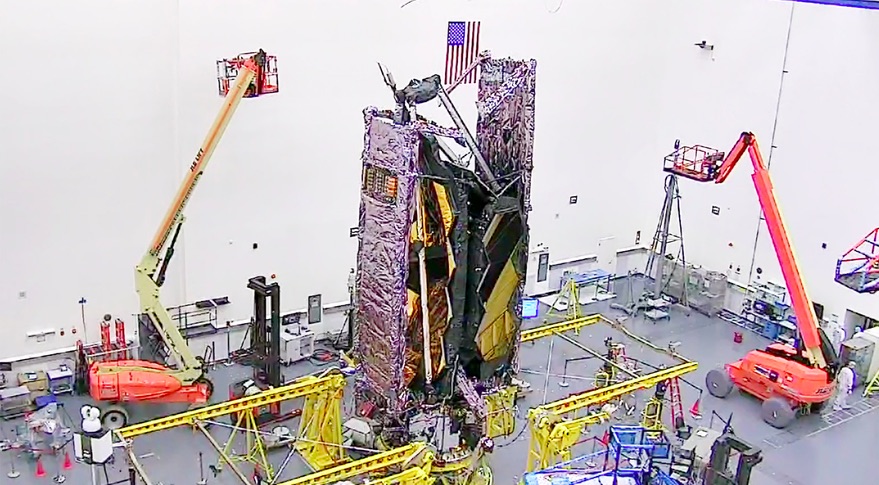WASHINGTON — NASA and Northrop Grumman are increasing work on the James Webb Space Telescope that slowed during the coronavirus pandemic, but the agency has yet to confirm a new launch date for the mission.
Integration and testing, or I&T, of JWST was in progress at a Northrop Grumman facility in Southern California when NASA decided in mid-March to have personnel assigned to oversee that work return home. While agency officials originally said that would effectively stop work on the flagship space telescope, activity has instead continued at a low level since then, including stowing the telescope in its launch configuration ahead of another round of vibration and acoustics tests.
Paul Hertz, director of NASA’s astrophysics division, said NASA personnel returned to the Northrop Grumman facility last week. Appearing at a June 1 NASA town hall event that was part of the 236th Meeting of the American Astronomical Society (AAS), held online, he said that Northrop Grumman was planning to resume a second daily shift of work on the telescope that had been suspended during the pandemic.
Jonathan Gardner, deputy senior project scientist for JWST at NASA’s Goddard Space Flight Center, said during a separate presentation about the mission during the AAS conference June 2 that, before the pandemic, Northrop was running 12 shifts a week of 10 hours each. During the pandemic, the company had just five shifts a week of eight hours each.
“We will be gradually ramping up the NASA presence and the number of shifts,” he said. That will support a comprehensive system test of the telescope and a pre-environmental review before the final set of vibration and acoustics tests. After that, the telescope will go through a final set of deployment tests of its major structures, including its large sunshield, before being stowed in its launch configuration again for shipment to the launch site.
Before work on JWST slowed down in March because of the pandemic, the mission was on schedule for a launch in March 2021, with 52 days of schedule reserve remaining. The amount of schedule reserve, though, led some to question if the mission could make that launch date. A Government Accountability Office report in January warned a launch next March “may not be feasible” given the amount of work remaining and the rate at which the project was using up schedule reserves.
NASA has not yet formally changed the JWST launch date. “We will have to evaluate the schedule and reassess what the most likely launch date is,” Hertz said. “At the moment, we’re still working towards the currently announced launch date.”
Hertz didn’t say when that schedule reassessment would take place. In January, NASA officials said that they planned to review and, if necessary, update the launch date during a review before the final set of environmental tests. At the time, that review was scheduled for May.
Gardner acknowledged that some kind of delay to the March 2021 date is likely. “We’re expecting a delay,” he said. “NASA is working through the process of determining what the schedule will be as we start to ramp back up on the I&T activities. We’ll take a hard look at that.”
The pandemic has affected other aspects of the mission as well. The Space Telescope Science Institute, which will manage science operations of JWST, released a call for proposals for a first round of observations, called Cycle 1, in January. At the time, proposals were due on May 1.
The institute, though, has delayed the due date for those Cycle 1 proposals, citing the pandemic. In a June 1 update, it announced that it has not set a new deadline for proposals, and won’t set one before mid to late July. The institute added it will provide at least 12 weeks’ notice of a revised deadline for proposals.
“What is at the top of our minds is the state of our community and the challenges they have been facing with this pandemic, so it was not tenable to keep the deadline as it was,” said Klaus Pontoppidan, JWST project scientist at the institute, during a June 2 presentation at the AAS meeting. He added that proposals can continue to be submitted and updated as the institute reevaluates the Cycle 1 schedule.
